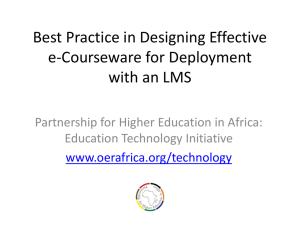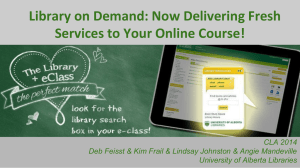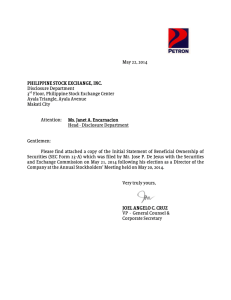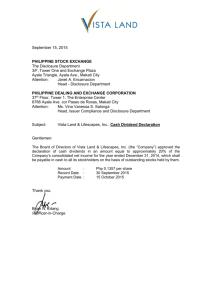A Special Online Education Model for the Graduate Degree
advertisement
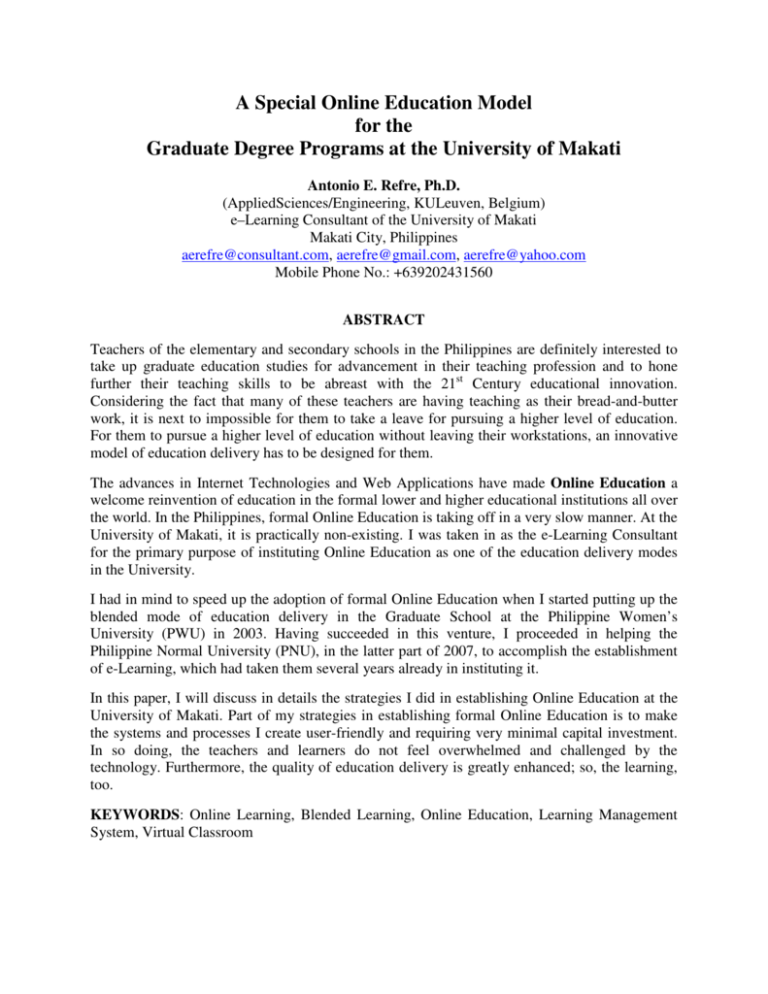
A Special Online Education Model for the Graduate Degree Programs at the University of Makati Antonio E. Refre, Ph.D. (AppliedSciences/Engineering, KULeuven, Belgium) e–Learning Consultant of the University of Makati Makati City, Philippines aerefre@consultant.com, aerefre@gmail.com, aerefre@yahoo.com Mobile Phone No.: +639202431560 ABSTRACT Teachers of the elementary and secondary schools in the Philippines are definitely interested to take up graduate education studies for advancement in their teaching profession and to hone further their teaching skills to be abreast with the 21st Century educational innovation. Considering the fact that many of these teachers are having teaching as their bread-and-butter work, it is next to impossible for them to take a leave for pursuing a higher level of education. For them to pursue a higher level of education without leaving their workstations, an innovative model of education delivery has to be designed for them. The advances in Internet Technologies and Web Applications have made Online Education a welcome reinvention of education in the formal lower and higher educational institutions all over the world. In the Philippines, formal Online Education is taking off in a very slow manner. At the University of Makati, it is practically non-existing. I was taken in as the e-Learning Consultant for the primary purpose of instituting Online Education as one of the education delivery modes in the University. I had in mind to speed up the adoption of formal Online Education when I started putting up the blended mode of education delivery in the Graduate School at the Philippine Women’s University (PWU) in 2003. Having succeeded in this venture, I proceeded in helping the Philippine Normal University (PNU), in the latter part of 2007, to accomplish the establishment of e-Learning, which had taken them several years already in instituting it. In this paper, I will discuss in details the strategies I did in establishing Online Education at the University of Makati. Part of my strategies in establishing formal Online Education is to make the systems and processes I create user-friendly and requiring very minimal capital investment. In so doing, the teachers and learners do not feel overwhelmed and challenged by the technology. Furthermore, the quality of education delivery is greatly enhanced; so, the learning, too. KEYWORDS: Online Learning, Blended Learning, Online Education, Learning Management System, Virtual Classroom Introduction The advances in Internet Technologies and Web Applications have made Online Education a welcome reinvention of education in the formal lower and higher educational institutions all over the world. In the Philippines, formal Online Education is taking off in a very slow manner. I had in mind to speed up the adoption of formal Online Education when I started putting up the blended mode of education delivery in the Graduate School at the Philippine Women’s University (PWU) in 2003. Having succeeded in this venture, I proceeded in helping the Philippine Normal University (PNU), in the latter part of 2007, to accomplish the establishment of e-Learning, which had taken them already several years in putting it up. In this paper, I will discuss in details the strategies I did in establishing Online Education at the University of Makati. Part of my strategies in establishing formal Online Education is to make the systems and processes I create user-friendly and requiring very minimal capital investment. In so doing, the teachers and learners do not feel overwhelmed and challenged by the technology. Furthermore, the quality of education delivery is greatly enhanced; so, the learning, too. The Strategy in Establishing Blended Learning The main strategy I followed hinged on the development of an online learning platform that focuses on the creation of a Learning Management System (LMS). Choices I had were to (a) purchase a commercially-available LMS (e.g. WebCT or Blackboard), (b) get an Open Source LMS (e.g. Moodle), and (c) self-develop an LMS (which I can do being already an accomplished Web Applications Developer). Many local academic institutions cannot afford to purchase the WebCT or Blackboard. The University of Santo Tomas (UST) has Blackboard with a licensing cost of around Php 1M per year. UPOU and DLSU have Moodle. They get the standard Moodle free. To configure Moodle and administer it requires them to have a regular team of PHP&MySQL professional programmers (amateurs will just mess it up). This makes Moodle also an expensive choice. What was the option left for me then? Self-develop an LMS. Thus, I had to develop an LMS that will not require large investment in the development, operation, administration, and management. To make it readily acceptable to the users, I had to design it in a way that will make it very user-friendly and with features that will enhance learning among the users. The Design of the Self-Developed LMS (AERVLES) A Learning Management System (LMS) or also well-known as a Virtual Learning Environment System (VLES) is a software system designed to facilitate teachers in the management of educational courses for their students, especially by helping teachers and learners with course administration. The system can often track the learners' progress, which can be monitored by both teachers and learners. While often thought of as primarily tools for distance education, they are most often used to supplement the face-to-face classroom. Thus, Blended Learning (F2F+Online) came to existence. This system usually runs on servers, to serve the course to students and teachers as Web pages. The components of this software system usually include templates for content pages, discussion forums, chat (not recommended for formal academic courses), quizzes and exercises. Teachers fill in these templates and then release them for learners to use. Services generally provided include access control, provision of e-learning content, communication tools, and administration of the user groups. The design of the AERVLES platform is patterned after that of the Yahoo!Groups platform (http://groups.yahoo.com/). The application development software I used is PHP (http://php.net/) with database MySQL (http://www.mysql.com/). These are all Open Source software (no license fee; free-to-use!). The scripts are embedded in HTML documents. All the scripts and databases are hosted in a server provided by a Webhosting Provider in the United States. I chose Bluehost.com for my service provider. The initial two (2) years service costs $166.80. With this, the purchase of a server is done away with (Bluehost provides unlimited server space!). Also, there will be no need of technical personnel to maintain and operate the server (Bluehost provides highly professional technical support through extra-fast Live Chat). To make the AERVLES more robust, I added a system for administering the registration and assigning of teachers and students to the subjects being conducted online. In addition, I have developed a system for monitoring the conduct of the online courses by the Dean or by an Academic Supervisor to assure a high quality of education delivery. All these systems are integrated in the AERVLES. Training The other part of my Strategy is the training of the teachers in conducting online courses. The training is not focused on the use of the technology but more on the online pedagogy. Practically every teacher is familiar in using emails (this self-trains the teacher on how to use the computer and the Internet). The teachers have long been drilled already in their face-to-face (F2F) classroom teaching. Online pedagogy includes the F2F teaching strategies. One innovation I have introduced in the training of teachers is the use of e-book format for the production of the course materials. I have been using the software DeskTopAuthor. You may visit the website: http://www.desktopauthor.com/ to see all the possible things you can do with it. Also, visit DrRefre’s e-Book Writing Tutorial: http://www.teachlearn-online.net/ebookwriting/ to learn how to write an e-book using Desktopauthor. The students do not need anymore the training. As they proceed and be immersed in their online learning inside the Virtual Classrooms, they simply get on-stream easily. Besides, the Manual on how to use the AERVLES is freely available and downloadable from the Virtual Classroom. The LMS of the University of Makati (UMak) using the AERVLES Virtual Classrooms The AERVLES is a single piece of software, accessed via standard Web browsers, which provides an integrated online learning environment. It is depicted in the Figure 1 on UMak Online Education. The Virtual Classroom features are shown in Figures 2, 3, and 4. Its framework is based on an integrated model where most of the learning takes place via collaborative online activities and content is largely determined by the learners, either individually or as a group. Learning is very much student-centered and highly collaborative. It can be used to support flexible and distance learning. It includes the following functions. The UMak Online Education: http://www.umakonline.net/ Figure 1: The Main Page Figure 2: The Student Login Figure 3: The Student Classes Figure 4:The Student Virtual Classroom 1. Controlled access. This means controlled, secure, access to the curriculum that has been mapped to elements which can be separately assessed and recorded. It allows the organization of students into virtual classes, with individual, secure log-ins. Content is organized in elements or modules and mapped to learning outcomes of programs, linked to the units of which they form a part. Students should have their own individual, customized workspaces. 2. Student Tracking. Tracking student activity and achievement against these elements using simple processes should make it possible for tutors to define and set up a course with accompanying materials and activities to direct, guide and monitor learner progress. The AERVLES allows recording of certain basic information about students, irrespective of the learning context, including registration details, course details, course prerequisites, qualification aims, study time and tracking information. It offers comprehensive tracking and recording facilities. For example, it automatically records individual students' log-in time and dates, length of time online, what content has been read and how often, assessments completed, with dates and times of these activities. Ideally, the username and passwords used to control access to the AERVLES is the same as those used for other systems within the institution, to allow a 'single log-in'. It should not be necessary for a user to log in several times to access different systems. 3. Resources and materials. The AERVLES supports online learning, including access to learning resources, assessment and guidance. The learning resources may be self-developed or professionally authored and purchased materials. The AERVLES is able to support a variety of content formats, not only hypertext markup language (HTML). It can easily transfer content between VLEs either because institutions (or consortia) have different VLEs or because it is necessary to change VLE (in light of circumstances such as the supplier going out of business). The AERVLES provides a simple method of uploading content into the environment, so that it is then available for the creation of learning programs and pathways. Methods of doing this will vary from simple drag-and-drop to more complex uploading processes, including batch uploading of files and courses. Once uploaded, contents’ elements have to be assembled into programs of learning, which will mean devising pathways through the content, creating hierarchical structures, building links, etc. Again, the way this is implemented should make it easy for non-technical staff to use. From the student point of view, the AERVLES offers simple navigation tools through the content, and they should be able to access their own course details and performance information. 4. Communications. This includes communication between the learner, the tutor and other learning support specialists. There are three basic methods of communication within the AERVLES: email, bulletin boards and asynchronous discussion rooms. These facilities are likely to be heavily used to support the students and can be used for portfolio and assessment purposes. 5. Links. This means links to other administrative systems, both in-house and externally. The AERVLES integrates easily with core administrative/management systems which are IMS standards-compliant. Its data should be seamlessly shared with the MIS system. 6. Customization. The AERVLES is customizable. It allows the look and feel of the user interface to be customized, so that it can easily be redesigned to appear in the college colors, display the college logo, etc. Added systems into the AERVLES are the Academic Supervisor (features are shown in Figures 5, 6, and 7) and the Administrator (features are shown in Figures 8. 9, and 10). The Acdemic Supervisor features are shown in the following figures: Figure 5: The Academic Supervisor The Academic Supervisor is equivalent to the Coordinator of a group of teachers. The Academic Supervisor facility empowers the Coordinator to monitor the virtual classrooms of the teachers being coordinated. The virtual classrooms can only be viewed. In this manner, the Coordinator will be able to determine how the teachers he/she is coordinating are conducting their online courses. Figure 6: The List of Subjects Handled Figure 7: View of one Faculty Class The Administrator features are shown in the following figures: Figure 8: The Putting Up of Courses The Administrator Virtual Room takes care of the administrative functions that are similar to the Registrar functions. Courses/Subjects are put up in here. The teachers are assigned to these subjects; i.e they are given loads. Similarly, the students are assigned to the subjects they are enrolled in. All the virtual classrooms can be monitored for purposes of checking on how the teachers are conducting their online courses. Figure 9: Loading of Faculty Figure 10: Loading of Students CONCLUSION Delivery of formal courses in an online mode is not yet widespread in the schools in the Philippines. The author has developed a strategy that will not involve a very costly process in establishing Online Education. The AERVLES (an LMS developed by the author) is very userfriendly to both the faculty and the students. Furthermore, it empowers the Deans to monitor all the teachers which is practically impossible to do in an only F2F classroom instructions. The acquisition cost of the AERVLES is very much affordable. The administration and management costs are similarly very much affordable. To verify these claims, visit http://www.teachlearnonline.net/aersow/). The continued use of this AERVLES in the Online Education of the Philippine Women’s University since 2003 (see APPENDIX I) and of the Philippine Normal University since 2007 (see APPENDIX II) has demonstrated its cost-effectiveness and user-friendliness. WEBLIOGRAPHY 1. Desktopauthor: http://desktopauthor.com/ 2. DrRefre’s School on the Web. http://www.teachlearn-online.net/aersow/ 3. DrRefre’s Books Portal. http://www.teachlearn-online.net/aerbooks/ 4. DrRefre’s Tutorial in e-Book Writing. http://www.teachlearn-online.net/ebookwriting/ 5. DrRefre’s Seminar-Workshop in Online Teaching and Learning. http://www.teachlearnonline.net/olteach/ 6. LCCM-Online. http://www.lccm.edu.ph/online.php 7. MySQL: http://www.mysql.com/ 8. PHP: http://www.php.net/ 9. PNU-Online. http://www.pnu-online.net/ 10. PWU-Online. http://www.pwu-online.net/ 11. Yahoo!Groups: (http://groups.yahoo.com/). APPENDIX I The PWU Distance Education: http://www.pwu-online.net/ Figure 11: The Student Login Figure 12: The Student Classes Figure 13: The Student Virtual Classroom 3. Posted Files for posting assignments and works 4. Web References for posting websites that can be used as references 5. Class Discussion for collaborative learning through asynchronous discussion 6. Class Members for list of the members The features of the Virtual Classroom: 1. Bulletin Board for announcement 2. Course Contents for posting course materials. 7. Grade Check for seeing grades 8. Online Users to see who are also currently online APPENDIX II The PNU Online Education: http://www.pnu-onlne.net/ Figure 14: The Main Page Figure 15: The Student Login Figure 16: The Student Classes Figure 17: The Student Virtual Classroom
